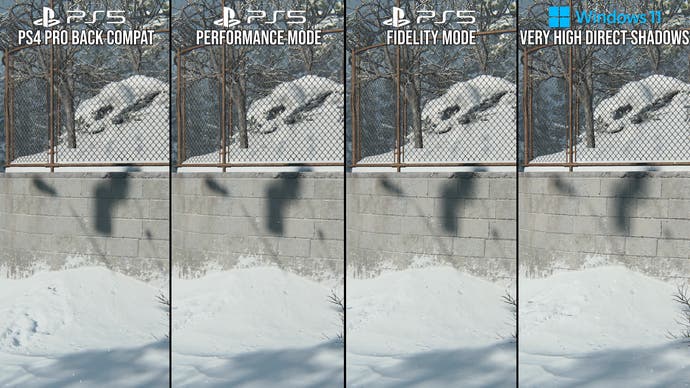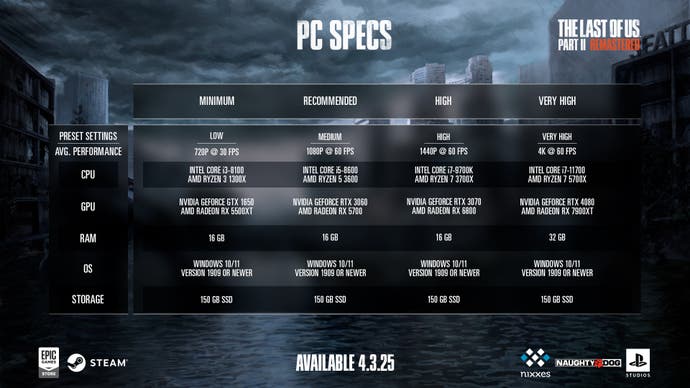The Last of Us Part 2 recently launched on PC, bringing the second part of the well-known Naughty Dog PlayStation adventure to a whole new audience. Port developers Nixxes build on the work previously done by Iron Galaxy for Uncharted 4 and The Last of Us Part 1 on PC, bringing new features and familiar limitations in almost equal measure.
We recently spoke to some of the key figures at Naughty Dog and Nixxes about the work they’ve done on the new port, which does launch in a much stronger state than its predecessor. Those figures include Naughty Dog’s programming director Travis McIntosh and game director Matthew Gallant and a host of developers from Nixxes: PC product director Coen Frauenfelder, principal optimisation director Wessel de Groot, junior graphics engineer Yana Mateeva, and senior director of development and studio head Jurjen Katsman.
As usual, the interview below has been lightly edited for clarity and length. Enjoy!
When did the project for The Last of Us Part 2 on PC begin? What are the origins of the current release?
Travis McIntosh: It was more than a year ago, maybe a year and three or four months ago, and actually Nixxes wasn’t available at the beginning. We always planned on working with them, but initially we worked with Iron Galaxy to produce an initial PC version. Some time in the fall of last year, Iron Galaxy rolled off, with Nixxes joining the project. We had a three or four month transition period and then they kind of took over lead development of the project around October, where they were the sole partner that we were working with, and they have done the bulk of the technical work. We’ve been talking throughout – at least once a week, sometimes three times a week, sometimes more. The bulk of the technical details have been done by them, with us standing over their shoulder and saying, “Hey, fix that. Fix that.”
What are the origins of the Naughty Dog engine on PC? It ships on DirectX 12, but presumably it must have existed in some prior form. Did anything on PC exist before porting begun, like a live editor, or did it need to be produced from the ground up?
Travis McIntosh: Obviously the work on The Last of Us Part 1 for PC helped with this. But if you want to start all the way at the beginning, before we had a PC version at all, there was almost no PC code. When we do PlayStation games, we are as low level as we can – as close to the metal as possible – and focus completely on a single platform. So there was very little PC support at all in the project. That all had to be brought up for Part 1 on PC, then on Part 2 we had to move that all over with Iron Galaxy. Nixxes joined us and started on the engine work when we were in the transition phase between porting over what we did for Part 1 to Part 2. The engine hadn’t changed that much between projects. So a lot of the lessons and technology that we built or learned on Part 1 got moved over to this project.
So from the Nixxes perspective, what were the key changes you wanted to make from Part 1 to Part 2?
Coen Frauenfelder: Well, of course, we have our own way of doing things for all of us at Nixxes. We wanted to bring over a lot of our knowledge that we already have, making sure that the game runs stably and performs very well. So we actually looked into what was already available, and building on that we brought over a lot of our own work. That took quite some time, but our experience helped a lot.
Travis McIntosh: I wanted to call out one thing that they did that really was awesome, in my opinion, the new PSO [shader] compilation scheme that’s in this game versus what we had in Part 1 on PC. So that was all Nixxes’ expertise, and I think it shows off how much better the experience is in this game.
That is actually our next question. Could you briefly describe how the new system gathers and compiles PSOs and how it differs from the previous system?
Wessel de Groot: In terms of gathering, it’s pretty much the same. We just let QA play the game and collect the PSOs. But the new system doesn’t do any pre-compilation in the main menu – it’s all hidden in the background and done during gameplay. The initial loading screen waits for all the PSOs to compile and, once that’s ready, lets go of the loading screen. Those are the basics of the new system.
So how do you exactly balance the load between compiling shaders in the background while keeping reasonable frame-rates and frame-times during gameplay?
Wessel de Groot: We try to minimize PSO threads in the background when gameplay is running and make the process as non-intrusive as possible. Also, if PSOs are not ready on time, then we actually skip the draw, and then we just bump the priority of that PSO compile. On the next frame, it’s hopefully done, and then we can actually show the object.
I’ve noticed thread utilisation go up when you regain control after a cutscene, which I presume is PSOs being crunched in the background. Does it happen every time after a cutscene, or what triggers it?
Wessel de Groot: It’s based on streaming. So whatever new stuff is streamed in, then the PSO compiles start.
OK, that makes sense, because we’ve seen similar utilisation when moving between areas – sometimes 20 seconds of compiling in the background when moving into a new area on a lower-end CPU. Another change is the addition of dynamic resolution scaling – what was it like adding that in?
Yana Mateeva: Oh yeah, it was interesting. The actual engine lent itself quite well to implementing dynamic resolution scaling. So on that front, it was not a very super difficult experience and it worked quite well. We did have some challenges with certain effects, which we did have to tweak specifically for PC to make them really compatible with dynamic resolution scaling. But yeah, it comes with the territory.
What cross-game libraries, other than dynamic resolution scaling, did Nixxes bring to this project?
Coen Frauenfelder: We brought a lot of them! We’re supporting DirectStorage, so we have our own libraries for that, and they also help a lot with streaming overall in the game. Besides that, all game inputs are going through our systems, as well as display handling and upscalers.
Could you talk about the changes to streaming, vis a vis DirectStorage?
Coen Frauenfelder: Actually, the system lends itself very well to DirectStorage. We’re just using CPU decompression, without GPU decompression. The new system gives us a lot of benefits – more room, better scalability on streaming things in faster.
Jurjen Katsman: One thing to maybe add is that we are using different compression algorithms which decompress really fast with low CPU usage, but use a little more disk space. We’d rather not spend too much time on unloading and decompressing in the background, so we make different trade-offs compared to PS5.
At SIGGRAPH 2020, there was a lot of presentations on the low-level work on PS4, but on PC with things like Shader Model 6, you do get wave intrinsics and asynchronous compute. Is the game using any of the more “low-level” features that are possible with DX12?
Wessel de Groot : We are using async compute and wave intrinsics. I’m not sure how it specifically compares to Part 1, because I didn’t work on that one.
Jurjen Katsman: I think it’s worth mentioning that while some of those concepts exist and can be used, it doesn’t necessarily level the playing field with the PS5. Certainly using async compute with the PS5, where you know exactly what the hardware is and what things pair well together, and there’s less driver in the middle, we’ve always found it to be a lot more beneficial on consoles than it is on PC, unfortunately.
Travis McIntosh: It’s just great on PS5, there’s almost nothing between us and the hardware. It’s just we know what we’re going to get, and we can build our command lists and just send them off and know exactly what’s going to happen. And props to Nixxes for figuring out how what might happen on 100,000 different configurations.

Going back to PSO compilation, in past ports there was a long shader burn for each sub-section of the game that would load. Even in the Uncharted games, switching between Uncharted 4 and Lost Legacy would make the PSO compiler begin again. Where are the wealth of PSOs coming from? Does the game just have a lot of shaders, or is it the state permutations from stuff you are not sure will be displayed?
Travis McIntosh: There’s no PSO loading or compilation on PS5, so the way we designed the engine is to give artists the most control and the ability to make the game look its best. Artists can tweak shaders on a very granular level, and because of that, we have way more shaders than we would if we were building a PC port from scratch. So it is a very large number of different permutations and that’s always been the challenge. And I think with how Nixxes handles it, it’s pretty seamless for most consumers.
It’s a night-and-day difference; loading chapters and getting into the game is much faster. Are PSOs the largest contributing factor in load times?
Jurjen Katsman: We have some numbers that we check internally, but yes most of the loading time is PSO compilation, so loading for the second time is massively reduced. The PC version can be much faster loading than the PS5 version, depending on your PC.
So in terms of challenges, you did mention the amount of shader permutations, but also the low level work that helps the game run well on PS5. What are the challenges in translating that to PC where things are less bare metal, and more abstracted?
Coen Frauenfelder: It’s a new engine to us, so that’s always a challenge. Once you get a version of the game running, you have to consider what you want to keep, what you need to pay more attention to to ensure the game is running perfectly.
Wessel de Groot: One thing is the spin locking. That is cheap on the console, but on Windows, that can be very problematic for performance. That’s one thing that we addressed for this port in particular.
‘
Did you switch to mutex?
Wessel de Groot: No, because that also has to do with the way that this job system works: it uses fibres. I’d say it’s one of the better job systems I’ve worked with in my career. So it’s a nice, well-optimised engine in that regard, which can’t really use a mutex due to the way fibres work. So we had to come up with a sort of a different construct for that. I think we managed quite well there.
That seems to be a change from the previous port, where even standing in an alleyway with nothing visibly happening, you could see extremely high CPU utilisation.
Travis McIntosh: Part of it is our fault – on PS5, no one cares what the CPU utilisation is. The job system was originally constructed to just always use everything, every second, and so moving that to PC, Nixxes was super helpful in helping to optimise utilisation as people on PC do care about it. It was challenging to reduce that as we never had to worry about it on console.
Looking towards the future, I imagine Naughty Dog will eventually want to bring other titles to PC. From the Nixxes perspective, are there any engine features that you’d like to see in future work that target PC more specifically?
Coen Frauenfelder: It’s probably quite difficult to talk about that, but I could see us focusing on ray tracing in the future.
We like to end these interviews with a familiar question: what was your favorite aspect of working on this project? What was it like working on this versus something like the PC version of Ghost of Tsushima?

Yana Mateeva: For me, it was entirely different, just because we started from scratch with Ghost of Tsushima and then we had to build it all up, whereas here we actually got quite a well-executed product already. We had to really think, “How can we improve this?” We were quite involved in, for example, tweaking the scalability for the game. Can we maybe make a better user experience? And that was quite an interesting part of the project for me.
Matthew Gallant: I don’t know if this is quite the angle you’re wanting on this, but we do have a bunch of new stuff in the PC version of the game. We have the new maps for “No Return”. Bill and Marlene are playable. And for players who choose to optionally link their PSN account, we have the jacket from Intergalactic, Jordan Mun’s jacket. We’re very excited that we got those into the PC version of the game.
Travis McIntosh: I personally just love ultra-widescreen. I love big wide screens at home. I played this game plenty, but I never got to play it like that, so that was really fun.
Coen Frauenfelder: Yeah, for me, it is actually very simple. It’s a beautiful product. I love The Last of Us. I played it, I think, on every platform that it came out on. Being able to work on that with Nuaghty Dog was a dream come true. But that’s a personal thing.
Wessel de Groot: Yeah, same. It’s one of my favorite franchises, so being able to work on that and seeing how it works internally was really awesome.
Jurjen Katsman: For me, what was the most different about this one is that we took something that had already been taken somewhere else by another partner. That makes you focus on deciding on what the added value we provide is. We things would we have done differently. You have to be on the look-out. You have to ask, “Did we miss something, something we didn’t touch at all?” So it was a very different experience. But nonetheless, I really appreciate Naughty Dog reaching out to us and working with us on this project, because, as Coen said, this is certainly a project that we would have never expected to ever work on back in the Square Enix days in 2020 when this came out.
Source link











Add comment